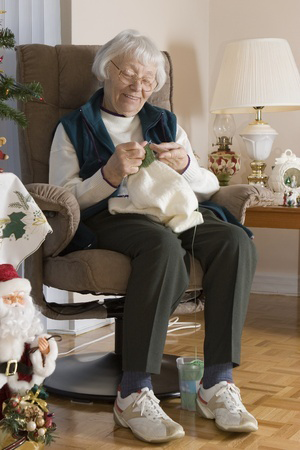 The winter is a particularly bad time of year for seniors with balance issues. Icy sidewalks and slippery, wet driveways are hazard enough, but cold weather also keeps people indoors. Unfortunately, being cooped up for long periods of time indoors can lead to an increased risk of falling.
The winter is a particularly bad time of year for seniors with balance issues. Icy sidewalks and slippery, wet driveways are hazard enough, but cold weather also keeps people indoors. Unfortunately, being cooped up for long periods of time indoors can lead to an increased risk of falling.
Many independently living seniors have not made accessibility modifications to their homes as they have aged. And obstructed hallways, cluttered living rooms, large furniture, high shelves and lack of non-slip mats or handrails in passageways and bathrooms can spell disaster for a senior who suffers reduced mobility.
This winter, it may be time to make some of those modifications.
Falls are a major cause of serious injury in older people.
According to the Centers for Disease Control, falls are the leading cause of both fatal and non-fatal injuries in older adults. Falls can cause hip fractures, paralyzing back and neck injuries, and even traumatic brain injuries.
The long-term prognosis for a person over 65 who suffers a serious fall-related injury is often poor. The CDC estimated that over 21,000 elderly Americans died from unintentional fall injuries in 2010 alone. Injuries secondary to falls were listed as the fifth leading cause of all US deaths for that year— young and old combined.
Even non-fatal falls can be catastrophic.
For seniors with diabetes, which causes reduced circulation in the extremities and delayed healing of wounds, the consequences can be serious— wounds incurred in falls can result in serious infections that require hospitalization or can even result in lost limbs.
Seniors who take daily blood-thinners, like Coumadin or Plavix, can develop internal bleeding when they fall. If this bleeding occurs in the head or in vital organs, the resulting injuries— even if nonfatal— can reduce a person's overall quality of life or lead to permanent incapacitation.
Fall-related injuries are costly. According to the CDC, "in 2012, emergency departments treated 2.4 million nonfatal fall injuries among older adults; more than 722,000 of these patients had to be hospitalized."
The total cost of these hospitalizations cost an estimated $30 billion in that year; such yearly totals are expected to rise as the American population ages.
Moreover, lingering fall injuries can exacerbate previous mobility issues, making it harder for seniors to walk or perform the tasks of daily living. It is therefore crucial that you take steps to reduce your chances of falling at home.
Fall safety home modifications don't have to be ugly or boring.
In fact, they can be accomplished quite stylishly, as ApartmentTherapy has shown on its design blog.
Many interior decorators and interior design specialists specialize in redesigning homes to increase seniors' safety. When you redesign or redecorate your space, keep the following fall prevention principles in mind:
Wider spaces equal safer places.
Sell off, gift, or donate big, heavy pieces of furniture that obstruct foot traffic; buy smaller, stylish furniture or go with less.
Call a contractor and get estimates for a remodel.
Consider knocking out non-supporting, interior walls and open up larger living spaces or corridors. Widen exterior walkways, stoops and stairs and resurface them (and your driveway) with slip-resistant textures.
If you have trouble climbing stairs, install a lift.
If that is cost-prohibitive or undesirable, rearrange your home so that primary living spaces are all on the first floor.
Repaint or re-paper your interior walls in white or other bright colors.
Bright colors are more reflective of light, more light makes it easier to see and ease of sight reduces fall risk. Install recessed lighting, track lighting or a sleek, new table lamp or to brighten things up!
Get new shelving.
Install lower, easier-to-access shelving— particularly in the kitchen, closets and in the bathroom. It might be time for a kitchen and bathroom remodel, anyways, and there is no faster way to refresh the look of your home (and your spirits) than with a new set of utility surfaces. While you're at it, have the contractors install handrails in the tub and next to your new, raised-seat commode.
Before you rearrange and remodel, consult an occupational therapist.
An occupational therapist (OT) is a health care professional who can assess a senior's physical challenges or special mobility needs, work with him or her to develop new methods to safely and more easily perform daily tasks and recommend environmental or design changes tailored to specific mobility needs. By integrating an occupational therapist into your home redesign team, you and your designer might gain additional insights into modifications that can be made specifically to address any unique challenges you might face.
Fall prevention modifications are well worth the expenditure, if you consider the potential cost of a lengthy stay in an intensive care unit, plus rehabilitative care. This winter, keep yourself living well by taking steps to fall-proof your residence. But when you do, do it with style.












